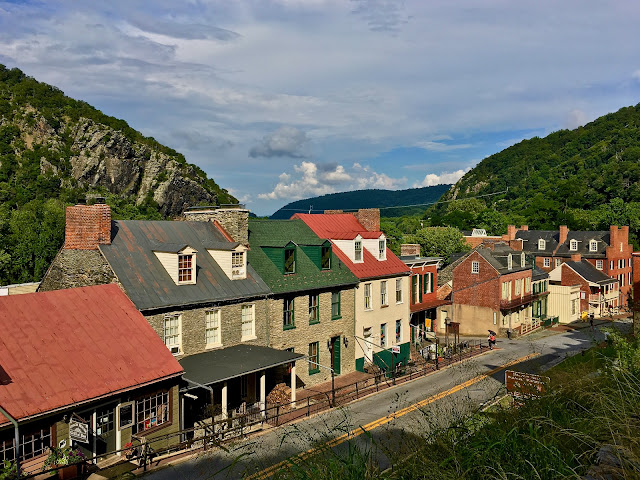 |
| Harpers Ferry, West Virginia |
Harpers Ferry, West Virginia is nestled in the Blue Ridge Mountains at the confluence of the Potomac and Shenandoah Rivers. Established in 1763, the town was a vital hub situated at the epicenter of American History concerning transportation, industry, slavery and the Civil War.
Thomas Jefferson visited the area in 1783 and upon seeing the dramatic gap in the mountains, he declared “the passage of the Potomac through the Blue Ridge is perhaps one of the most stupendous scenes in nature.” George Washington traveled there in 1794 and was impressed by the rugged beauty of the isolated outpost.
Washington eventually chose Harpers Ferry as the site for a new national armory and by 1796 the U.S. military arsenal was established. Merchants, mechanics and immigrants flocked to the western Virginia township because of the commerce generated by the machine shops and rifle works factories.
Probably the most famous event in the town’s rich history was abolitionist John Brown’s raid on the armory in 1859. Brown was vehemently opposed to slavery and armed with weapons taken from the federal arsenal, he intended to lead a slave revolt against the southern states.
Brown and his band of sympathizers took the fort by force but they weren’t able to hold it for long because a team of U.S. Marines, led by Lieutenant Colonel Robert E. Lee, stormed the compound and recaptured the facility. Brown was subsequently found guilty of treason and executed by hanging just up the road in Charles Town.
The raid and its tragic results captivated the nation while sparking a heated debate over the issue of slavery, catapulting the United States into a bloody Civil War. Once Virginia seceded from the Union, Confederate militia attacked the vulnerable armory.
Union troops stationed there were overwhelmed so they fled for Washington while burning the arsenal to the ground on the way out. Harpers Ferry sits on a low flood plain surrounded by towering heights so its position was impossible to defend and being on the line between North and South, the town was horribly ravaged by the conflict.
Possession of this strategic hotspot was difficult to maintain as opposing forces always bombarded it from the nearby mountaintops. Control of the town changed hands fourteen times and most of its homes and buildings were destroyed during the sieges.
The lone exception was Saint Peters Church which flew a British flag from its spire. Both sides respected this sign of neutrality so it survived the four years of war unscathed while serving as a field hospital and conducting Roman Catholic mass.
Today, echoes from the sleepy village’s violent past are barely audible but visual reminders are scattered everywhere down in the lower historic district. It’s fascinating to explore a place that’s shaped by such compelling stories and spectacular wilderness scenery.
The stoic landscape is brimming with lush greenery as lazy waterways meander through the melancholy mountains. While I enjoyed my visit to the East very much with its grand history, temperate climate and lush ecosystem, I still prefer to wander in the wide open West.
 |
| At the epicenter of American History |
 |
| The confluence of the Potomac and the Shenandoah |
 |
| Pedestrian bridge over the Potomac |
 |
| From the Appalachian Trail |
 |
| A fascinating place to explore |
 |
| Railroad bridge over the Potomac |
 |
| Saint Peters Roman Catholic Church |
 |
| Nestled in the Blue Ridge Mountains |
 |
| A sleepy village |
 |
| Most of the town was destroyed during the Civil War |
 |
| Saint Peters survived unscathed |















Comments
Post a Comment